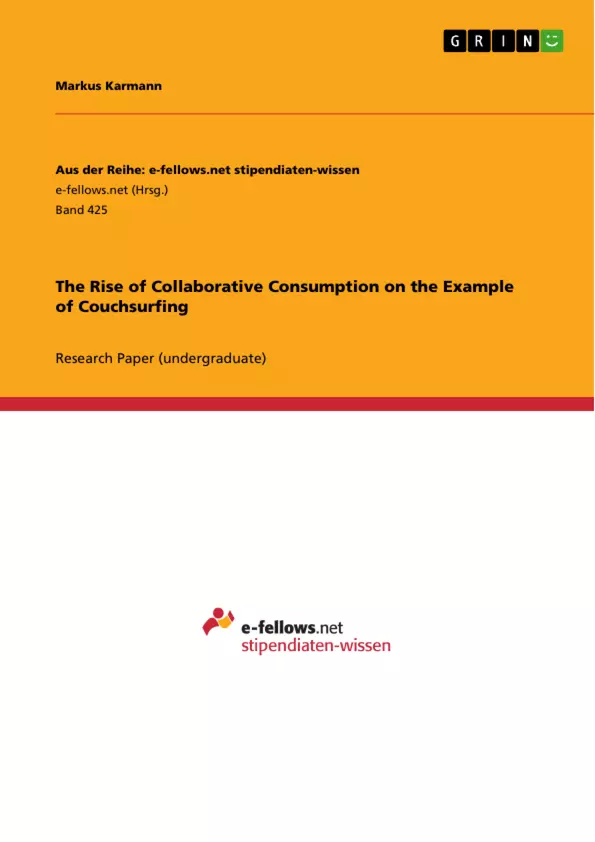The objective of this paper is to analyze the emergence and the characteristics of collaborative consumption. Moreover, this paper examines the causes and underlying motivations for using Couchsurfing as one particular form of collaborative consumption by focusing on consumers. Lastly, we will provide potential implications of this trend for commercial organizations.
In recent years economic life has changed more radically than in the past century altogether. Consumers and firms are getting away from the typical capitalistic principle of “buyers” and “sellers”. The new economies are rather defined by “users” and “suppliers”. Ownership, which was the underlying principle of decades of capitalism is not desirable anymore as it is “(..) considered outdated and out of place (..)” (Rifkin 2000, p. 5). Nowadays, firms are outsourcing and leasing cars, electronics and even people. It is just not important to own things anymore, but simply to have access to resources. Product life-cycles are becoming shorter and shorter and especially electronic goods are almost outdated shortly after their release. Therefore, companies need to be flexible and react quickly. The principle of ownership can just not fulfil the requirements of an ever-changing and fast-paced economy (Rifkin 2000).
While consumers are still more reluctant towards this trend, they are picking up on it. Car-sharing or bike-sharing, for example, is becoming more and more popular in order to (simply) save money and thus replace traditional ways of just buying goods. Furthermore, people are increasingly aware of their (negotiation) power. Groupon, for instance , is only able to offer all these “blockbuster discounts” because there is a huge mass of people behind (it) to “negotiate” big bargains. The rise of the internet and modern communication is an important building block of developing this kind of network economy. Without modern communication it is just impossible to coordinate a network economy and to identify suppliers, users and their needs (Rifkin 2000).
This general trend of (either) sharing goods or getting access to it is called “collaborative consumption”.
Inhaltsverzeichnis (Table of Contents)
- Objectives
- Theoretical Part
- Entering a new era of markets
- Collaborative consumption
- Trend
- What is collaborative consumption?
- Benefits of collaboration or why are people doing it?
- Suzi's daily routine
- Forms of collaborative consumption
- Why does it work?
- Implications of collaborative consumption on conventional businesses
- Couchsurfing.org as a Successful Example of a Lifestyle Peer-to-Peer Network
- Qualitative Research
- Research questions
- Research methodology
- Couchsurfing.org - Company profile
- Critical success factors
- Qualitative Research: Motivations behind Couchsurfing
- Quantitative Research
- Study Design and Participant Structure
- Membership and Frequency of Use
- Motivations
- Trust
- Couchsurfer characteristics
- Implications
- Conclusion
- Qualitative Research
- References:
- Appendix
- Questionnaire
Zielsetzung und Themenschwerpunkte (Objectives and Key Themes)
This paper explores the emergence and characteristics of collaborative consumption, specifically focusing on the reasons and motivations behind the use of Couchsurfing as a form of collaborative consumption by consumers. The paper also examines the potential implications of this trend for commercial organizations.
- The shift from traditional ownership-based consumption to access-based collaborative consumption
- The motivations and benefits of collaborative consumption for individuals and businesses
- The role of technology in facilitating and accelerating collaborative consumption trends
- The case study of Couchsurfing as a successful example of a lifestyle peer-to-peer network
- The implications of collaborative consumption on traditional business models
Zusammenfassung der Kapitel (Chapter Summaries)
The paper begins by discussing the emergence of collaborative consumption, highlighting the shift from traditional ownership-based models to access-based models. It explores the key drivers and motivations behind this trend, including economic benefits, community building, and the desire to simplify life. The paper then delves into the specific example of Couchsurfing, examining its success as a lifestyle peer-to-peer network. This section analyzes the motivations behind Couchsurfing participation, the role of trust in the network, and the characteristics of typical Couchsurfers.
Schlüsselwörter (Keywords)
Collaborative consumption, Couchsurfing, peer-to-peer, access-based consumption, sharing economy, community, trust, social networking, business implications.
- Citar trabajo
- Markus Karmann (Autor), 2011, The Rise of Collaborative Consumption on the Example of Couchsurfing, Múnich, GRIN Verlag, https://www.grin.com/document/193110



